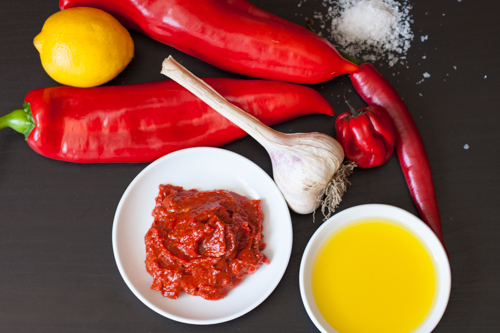Harissa
 Wednesday, July 19, 2017 at 9:04PM
Wednesday, July 19, 2017 at 9:04PM 
Harissa, if you haven’t discovered it yet, is a vibrant Middle Eastern condiment that can be added to many dishes to give them a zesty hit of sweet and spice and all things nice.
It goes particularly well with lamb. I often use it as a condiment alongside roast lamb, coated lamb chops in it, slathered it on burgers and my new favourite, in a bun with merguez sausage, mayo and rocket.
It can also work with chicken or a meaty fish, like monkfish or hake, so long as you are not too heavy handed. I love adding a tablespoon or two to a tomato-based stew, such as my chicken, chorizo and chickpea stew or albondigas. You can also stir it through mayonnaise or yogurt to give them a bit of a kick.

Harissa is generally either sweet and a little bit spicy or salty and very spicy. Depending on what you are using it for, it’s worth adjusting the recipe. If you will be using it as a standalone condiment alongside, say, a rack of lamb, I’d go for a sweeter, milder version. If you are going to use it in a marinade or stir it through mayo or yogurt, then I’d go for something more potent.
The recipe below is a sweeter style, mainly because of the Romano peppers. If you like it even sweeter, then add a caramelised red onion, either slowly sautéed in a pan with some olive oil or oven-roasted.
You can adjust this recipe for a saltier, spicier version by removing the Romano peppers and exchanging them for 10 long, mild red chillies. The rest of the recipe remains the same.

Ingredients
3 tbsp olive oil, approx
2 Romano peppers
1 mild red chilli
1 hot red chilli
4 cloves garlic
1 tbsp tomato paste
½ tsp cumin seeds, toasted and ground
½ tsp coriander seeds, toasted and ground
½ tsp caraway seeds, toasted and ground
½ tbsp lemon juice
Salt, to taste
Method
Preheat the oven to 150C.
Rub the peppers in some of the olive oil (this makes the skins easier to remove later) and grill over an open flame – if you don’t have a BBQ then you can use a gas burner.
Cook each until most of the skin is charred, turning to blister each side. Be careful not to cook each side for too long as the flesh is thin and you may burn it all the way through. It is unlikely that you will get them black all over without burning the flesh so when they are mostly charred, pop them on an oven tray and finish cooking them in the oven till they are soft.
Do the same with the chillies, being even more careful not to burn them too much. Place in the oven with the peppers and the garlic cloves in their skins.
When you remove the peppers and chillies from the oven, put them in an airtight container to steam and cool (this also makes the skins easier to remove). When cool, remove the skin and cut in half to remove the seeds and pith. Discard the tops.
Put the peppers and mild chilli in a blender along with the roast garlic, tomato paste, ground spices, 1 tbsp olive oil and lemon juice. Blend and add a little of the hot chilli, to taste. Add more if required. Season with salt, to taste.


Reader Comments (1)
I have always been a "fan" of caraway seeds, but had no idea that the entire plant was edible.